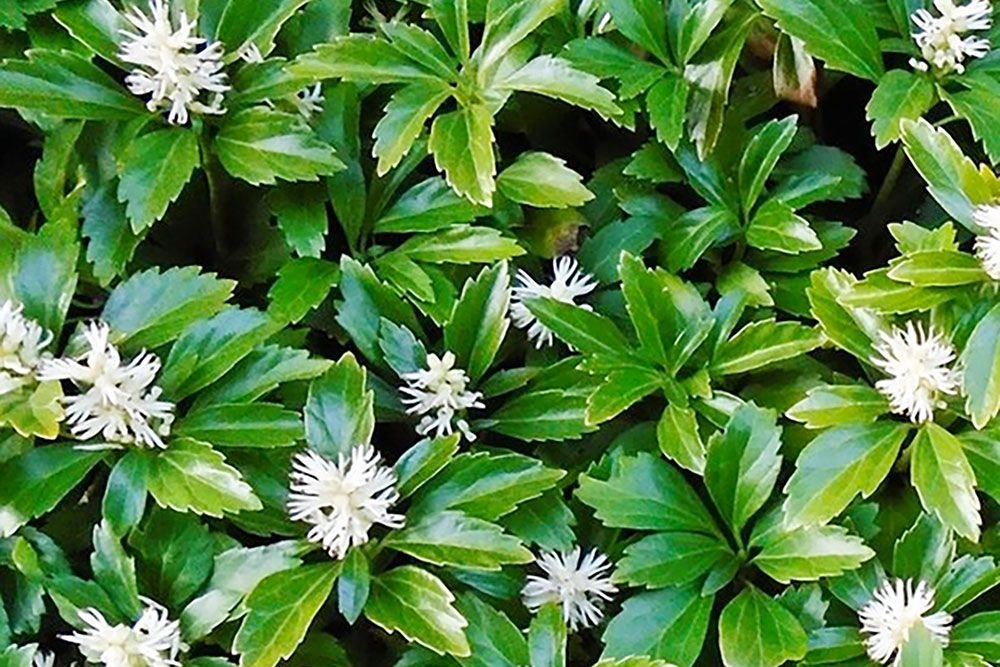Invasive plant spreads easily, is toxic to cats

Invasive plant Japanese Spurge is toxic to cats and is hard to remove as it spreads easily and can regenerate from small piece of root
Invasive Plant of the Month Feature – Japanese Spurge – Pachysandra terminalis
By Renee Sandelowsky and Helen Varekamp
Renee Sandelowsky and Helen Varekamp are Bayfield residents and local volunteers. They are writing a monthly series of articles, for the Canadian Coalition for Invasive Plant Regulation, about the benefits of planting native species of plants and removing invasive species. This month (August 2025), their focus is the invasive plant Japanese Spurge – Pachysandra terminalis.
Japanese Spurge is also called Pachysandra. It originates from Asia and it is a rampant groundcover plant.
This invasive plant is an evergreen perennial herb in the Boxwood family. It can reach one foot in size and it can spread to form dense mats.
The flowers are white and appear between March and April. Fruits are on terminal branches and are extremely small. The plants reproduce vegetatively through underground stems and roots. This plant is often used in shade gardens.
Japanese Spurge can regenerate from the smallest piece of root, making it especially easy to spread, and hard to remove.
This invasive plant can escape into forested areas and meadow edges. It is resistant to deer and, therefore, speeds up displacement of native vegetation.
Despite this invasive nature, Japanese Spurge is still available for sale in many garden centres. Please do not buy this plant and please do not trade it with your neighbours.
Japanese Spurge is toxic to cats.
How to manage Japanese Spurge
Managing Japanese Spurge is quite achievable with persistence and a multi-step approach:
Manual Removal:
Removal is most effective when the soil is moist. For small populations, dig up the plants and roots – which are white and easy to see – and remove manually. Check in the coming months for new plants emerging, as even the smallest bit of root can resprout. Do not put plants in the compost or municipal green waste. Put them in the garbage instead.
Smothering:
Another option for small or larger populations is to cover infested areas with tarps or cardboard to block sunlight. Cut the Pachysandra back to ground level before smothering.
Herbicide Treatment:
Difficult-to-reach or large areas may be treated by herbicide. Use herbicides only as a last resort, following all applicable regulations to minimize environmental harm.
After removal, replant the area with regionally appropriate native species of plants. This step is essential to prevent reinfestation and to restore ecosystem health. Native plants will also attract pollinators and wildlife, improving biodiversity in your garden.
A good choice, as an alternative, would be Wild Ginger – Asarum canadense
Learn More and Take Positive Action
Education is key to combating invasive plants. Learn to identify invasive species and choose native or non-invasive alternatives for your garden.
Focus on managing one or two invasive plants at a time and be patient — successful eradication takes time and persistence.
For more information, visit:
- Ontario Invasive Plant Council
- Canadian Coalition for Invasive Plant Regulation
- Grow Me Instead Guide
Why should we get rid of invasive plants?
Invasive plants can impact agriculture, forestry, recreation, biodiversity, ecosystem health, and public health.
Control of these species costs hundreds of millions of dollars annually. Additionally, there are the inestimable costs to our natural environment — our life-support system.
Invasive plants can:
- Suppress or displace native plant species
- Disrupt essential food webs and impact wildlife
- Change litter decomposition, soil formation, soil chemistry and the distribution of soil organisms
- Reduce the availability of resources, like water or nutrients
- Impair essential ecosystem function and services, like pollination
- Diminish native habitats
- Reduce genetic diversity and biodiversity
Invasive plants can have these impacts on human health and well-being:
- Increased hazards to human health (poisonings, allergies, dermatitis, injuries, disease – Lyme disease, West Nile virus)
- Threats to food production
- Diminished recreational opportunities (bird watching, hiking, camping)
- Depression and mental health impacts associated with losses and management
- Loss of our unique natural legacy (Indigenous cultural heritage; maple sugar production; beauty of Canadian landscapes)
Economic impacts of invasive species include:
- Costs for removal or control
- Negative impacts on agriculture, forestry and fisheries
- Loss of revenue from tourism, hunting, fishing and recreation
- Damage to infrastructure (e.g., drainage systems, transportation corridors)
- Increased risks of fire, erosion, and property damage
- Reduced property values